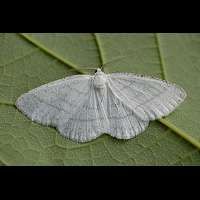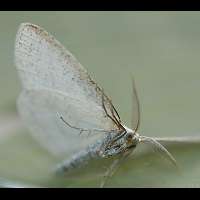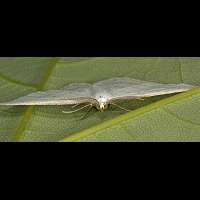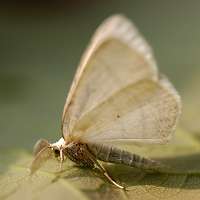Common White Wave (Cabera pusaria)
The Common White Wave is one of a group of whitish geometers showing some darker bands, waves, smears of dots. In his case there are three grey lines over the wings. The upper two may be hardly visible at times, but the last one is always there, even in very worn out animals. It is very similar to the Common Wave. Yet you can tell them apart by examining the lines, especially the last one. In the Common Wave the line runs slightly rounded and there is an obvious bend in the middle. In the Common White Wave the line runs straight from side to side with no visible bends. Another similar species is the Cream Wave, but it usually has more than 3 visible lines, which are more edged and not wavy. It also has black dots in the middle of the hind wings. The Common White Wave isn't very variable in size, for the wingspan is some 32 to 35 mm.
The first eggs will hatch in June. Many of the caterpillars are bright green with some greenish smears, dots and speckles and a few purple dots on the back. Others however are brown with brownish smears. They often also show purple or blackish dots on the back. The larvae are quite slim and reach a length of some 30 mm. Many pupate in July to deliver the second generation of moths, others wait till the following year, accompanied by the caterpillars of the second generation. They drop on the ground in autumn, spin a cocoon between leaflitter and pupate inside. The pupa then overwinters. The larvae of the Common White Wave feed an most trees and shrubs.
In Southern Britain the Common White Wave is double brooded and on the wing from the end of May to the end of August. There is however a gap between the first and second generation in the beginning of July. In Northern Britain there is only one generation, on the wing from May to the end of July. It can be seen flying about from early dusk and is easily disturbed during the day. This is a very common species all over Europe, including most of Britain.
The Common White Wave is one of a group of whitish geometers showing some darker bands, waves, smears of dots. In his case there are three grey lines over the wings. The upper two may be hardly visible at times, but the last one is always there, even in very worn out animals. It is very similar to the Common Wave. Yet you can tell them apart by examining the lines, especially the last one. In the Common Wave the line runs slightly rounded and there is an obvious bend in the middle. In the Common White Wave the line runs straight from side to side with no visible bends. Another similar species is the Cream Wave, but it usually has more than 3 visible lines, which are more edged and not wavy. It also has black dots in the middle of the hind wings. The Common White Wave isn't very variable in size, for the wingspan is some 32 to 35 mm.
The first eggs will hatch in June. Many of the caterpillars are bright green with some greenish smears, dots and speckles and a few purple dots on the back. Others however are brown with brownish smears. They often also show purple or blackish dots on the back. The larvae are quite slim and reach a length of some 30 mm. Many pupate in July to deliver the second generation of moths, others wait till the following year, accompanied by the caterpillars of the second generation. They drop on the ground in autumn, spin a cocoon between leaflitter and pupate inside. The pupa then overwinters. The larvae of the Common White Wave feed an most trees and shrubs.
In Southern Britain the Common White Wave is double brooded and on the wing from the end of May to the end of August. There is however a gap between the first and second generation in the beginning of July. In Northern Britain there is only one generation, on the wing from May to the end of July. It can be seen flying about from early dusk and is easily disturbed during the day. This is a very common species all over Europe, including most of Britain.








